 January 22, 1855
January 22, 1855
The first step in placing an order began with the opening of official correspondence. Grinnell, Minturn and Company did this on 22 January 1855 by writing a letter of introduction for Elias Wade, Jr., a partner in their firm who was to serve as their point of contact with DuPont. Wade conducted much of the correspondence between the two companies and handled many of the details for their powder orders.
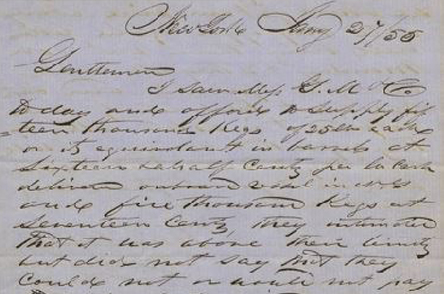
January 27, 1855
The Hazard Powder Company, with whom Grinnell, Minturn and Company was also negotiating for powder, contacted DuPont on 27 January about these discussions. Hazard informed DuPont that their two firms were the only ones that Grinnell, Minturn and Company had opened serious talks with. In light of this and other market conditions (such as explosions at other powder mills), Hazard proposed that they and DuPont set a minimum price. Both companies agreed on 16 1/2 cents per pound and independently communicated this to Grinnell, Minturn and Company.
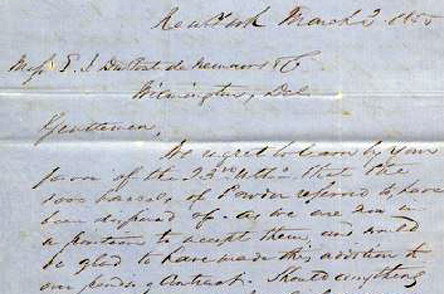 March 3, 1855
March 3, 1855
Grinnell, Minturn and Company then needed to specify what types and amount of powder they wanted. To meet the demands of the English military, they hoped to get as much powder as DuPont could provide. They wanted cannon powder to make up 5/6 to 4/5 of the total amount, the remainder being musket powder. They also stipulated that the powder's quality be the same as that supplied to the U.S. Ordnance Department.
 April 2, 1855
April 2, 1855
After Grinnell, Minturn and Company agreed to DuPont's and Hazard's price, both companies began packing powder on hand and manufacturing new powder to fill the order. As production and packaging progressed, Grinnell, Minturn and Company wanted to visually inspect and proof* the powder to insure its quality. The companies arranged a time when Elias Wade, Jr. and a Captain Warlow of the English military's Ordnance Department could visit the DuPont factory and inspect the powder.
*Proofing powder involved igniting it in devices called eprouvettes, which tested qualities of gunpowder such as strength and quickness of burn.
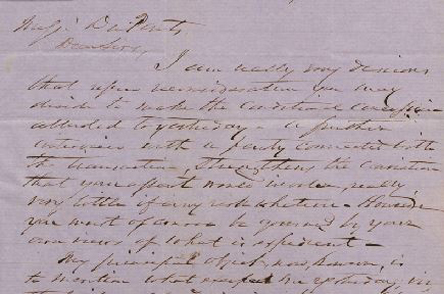 April 14, 1855
April 14, 1855
Following Wade and Warlow's visit to the DuPont powder yards, negotiations over the gunpowder purchase continued. Prices and terms of payment needed to be settled. DuPont confirmed that the powder's selling price was 16 1/2 cents per pound and that Grinnell, Minturn and Company could pay with a series of promissory notes that would come due over the course of several months.
DuPont also inserted a contingency clause in the agreement stating that in the unlikely case the United States should become involved in the Crimean War, the contracts would cease and all of DuPont's powder would go to the U.S. military.
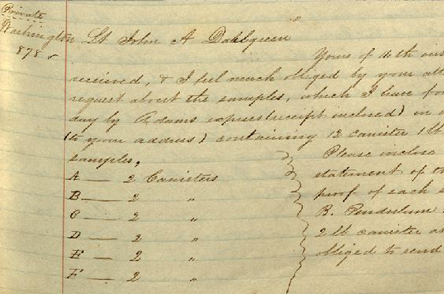 April 23, 1855
April 23, 1855
Grinnell, Minturn and Company wanted, in addition to its own tests, an outside source to proof samples of DuPont's powder. They suggested that DuPont send powder to Lieutenant John A. Dahlgren, a recognized gunpowder expert with the U.S. Navy's Ordnance Bureau in Washington, D.C. DuPont agreed and sent samples to Dahlgren on 23 April.
Much to Grinnell, Minturn and Company's consternation, Dahlgren had to delay his proofs by almost a month because the firing would disturb shad fishing on the Potomac River.
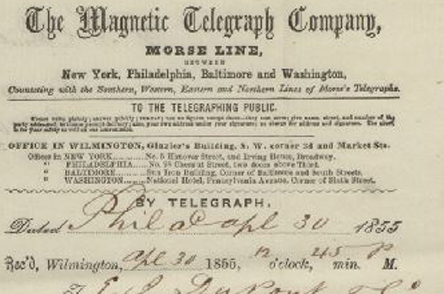 April 30, 1855
April 30, 1855
While the DuPont Company finished negotiations over payment and proofing, they instructed Francis Gurney Smith to charter a ship to transport the gunpowder from Wilmington, Delaware to New York. Smith served as DuPont's agent in Philadelphia and carried out numerous tasks for the company, including arranging transportation for gunpowder, retailing gunpowder in the Philadelphia area, and taking care of DuPont's financial matter with local banks.
Francis Gurney Smith charted the schooner C.H. Rogers to transport the powder for $600. The C.H. Rogers arrived at the DuPont Company wharf on the Christina River, near Wilmington on 2 May and commenced loading the same day.
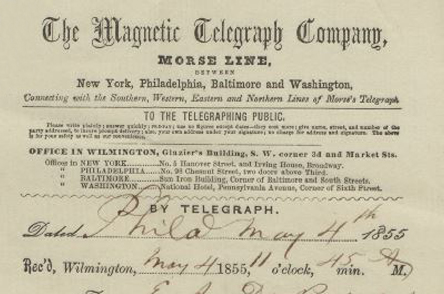 May 4, 1855
May 4, 1855
DuPont then asked Francis Gurney Smith to find a good rate for insuring the gunpowder. The shipment consisted of 3,117 barrels of gunpowder (each containing 100 pounds) valued at $51,560.50. Due to the difficulty in insuring an item like gunpowder, DuPont agreed to insure one half of the value and bill Grinnell, Minturn and Company for the amount.
Grinnell, Minturn and Company was responsible for insuring the other half. Francis Gurney Smith secured a rate of 1/2% for $26,000 (half of the powder's value) in Philadelphia amounting to $130.
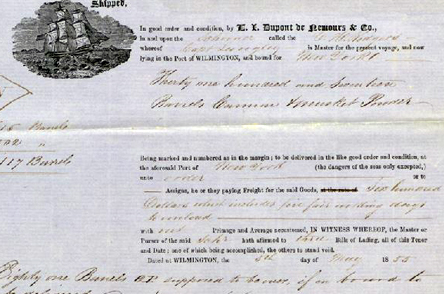 May 5, 1855
May 5, 1855
The C.H. Rogers completed loading on the morning of 5 May and sailed for New York that afternoon. DuPont noted that there was an inaccurate of how many barrels were loaded onto the C.H. Rogers because of clerical errors made during packing and transportation to the Christina River wharf.
The company informed Grinnell, Minturn and Company that there may be an error. This was also noted on the Bill of Lading, which was a statement of items loaded on board a vessel for shipping.
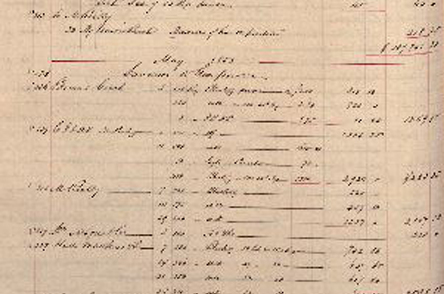 May 1855
May 1855
Once the powder was shipped, DuPont entered the order in their books along with the charge for insurance on one half of the gunpowder's value. DuPont Company clerks noted this transaction in the "Journal," which was a ledger book used to record specific transactions, usually by month.
Company bookkeepers used information from the Journal to keep track of customer accounts, financial transactions, raw materials purchased and used, and the amount of powder produced and sold. DuPont accountants used the Journal to compile information used the Journal to compile information used in the General Ledger at the end of the company's fiscal year.
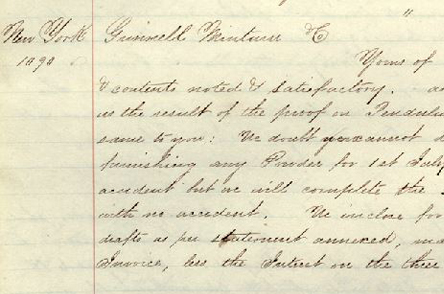 May 11, 1855
May 11, 1855
The C.H. Rogers arrived in New York on 11 May and began unloading the gunpowder on 12 May. Grinnell, Minturn and Company placed an agent on board the schooner to get an accurate count of the number of barrels sent. The agent found that the shipment contained two more barrels than expected and added them to DuPont's invoice for the powder. Grinnell, Minturn and Company received 3,119 barrels of gunpowder valued at $51,593.50.
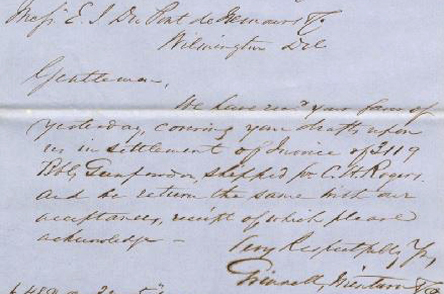 May 18, 1855
May 18, 1855
Grinnell, Minturn and Company had earlier agreed to pay DuPont with ten promissory notes. As per their agreement, two would be redeemable at three months, three at four months, and the remaining five at six months. DuPont made entries for the notes in their Journal that included the note's number, value, and term length. Acknowledging and entering the notes concluded the transaction between DuPont and Grinnell, Minturn and Company.
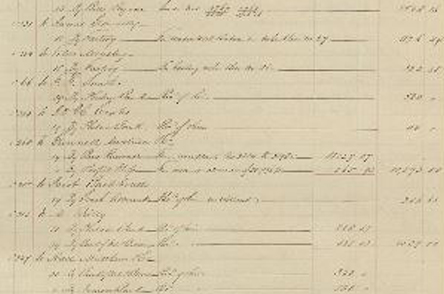
Discounting
DuPont then had to redeem the notes in order to get paid. The Company, following a common business practice in the mid-19th century, did not wait for the notes to mature and collect payment from their issuer. Instead, DuPont completed a transaction called discounting.
Profit and Loss
DuPont reimbursed itself for the sums lost through discounting Grinnell, Minturn and Company's notes. The Company paid the amount out of its "Profit and Loss" account. Monies in this account came from a portion of the company's profits at the end of their fiscal year.
DuPont used Profit and Loss to cover costs associated with explosions and other accidents, debtors' defaults on payments, lost or damaged inventory, and monies lost through financial transactions like discounting. Transferring money from Profit and Loss was not meant to make up for the losses, but rather to help insure the company's books would balance at the end of the fiscal year.
 June 6, 1855
June 6, 1855
Francis Gurney Smith took care of discounting Grinnell, Minturn and Company's notes at the Philadelphia Bank, where DuPont had an account. Smith discounted the first note. No. 2882 for $5,000 on 4 June. DuPont received $4,945 for this note, a loss of $55. Smith discounted Grinnell, Minturn and Company's notes over the next several months.
He disposed of one more in June, one in July, two in September, three in October, and the final two in November. Smith sent DuPont notice each time he discounted a note for them. DuPont clerks then recorded the discounted note in the Journal.
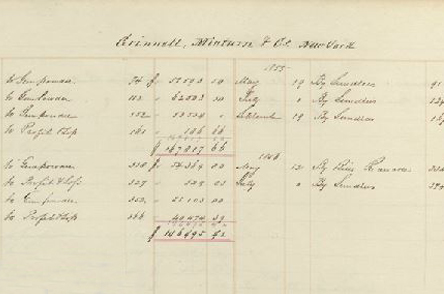 General Ledger 1855-1856
General Ledger 1855-1856
At the end of the fiscal year, DuPont noted Grinnell, Minturn and Company's orders and payments in their General Ledger. This ledger book served as a summary of the company's business for the previous year. Entries under Grinnell, Minturn and Company's account include three large orders for 1855, all of which were for the English government.
Making a gunpowder purchase during the 1850's was not an easy task, especially for large orders like the ones made for the Crimean War. A typical transaction involved negotiating prices, manufacturing and packing the gunpowder, inspecting the gunpowder, arranging shipping and insurance, delivery, and arranging payment. Grinnell, Minturn and Company's first gunpowder order with DuPont illustrates the complexities of the process.

